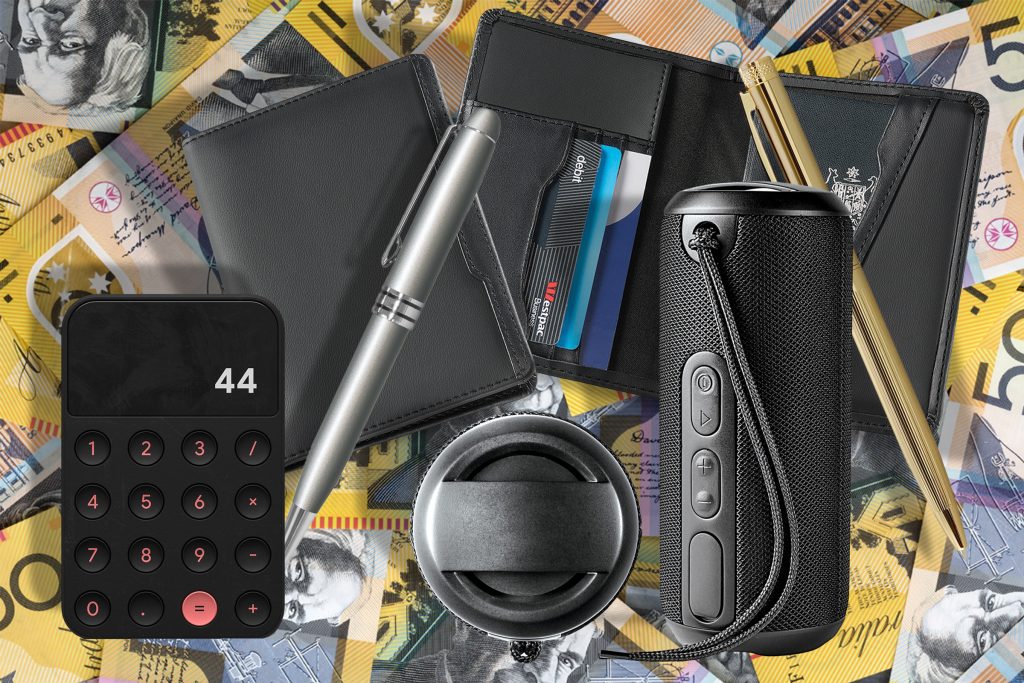WHAT DO PROMOTIONAL PRODUCTS COST? How pricing works in branded merchandise

Some promotional products are cheap and nasty, some are cheap and pretty nice. Most often though, they are reasonably priced and quite good quality. A full spectrum of pricing and quality exists in the branded merchandise world. If you’re willing to pay more money, you will get a promotional product that is beautifully crafted.
It’s important to put away the idea that all promotional products are cheap to buy and as such, will likely be thrown away within 24 hours. Instead, balance a branded product’s price against the value it delivers.
Read more about balancing cost and value in our article.
If you can readjust your perception of what branded merchandise is, you will open your eyes to the huge range that exists. We guarantee that there are products out there that you have not even imagined. They’re used for promotions, and they really are available to you.
Branded merchandise pricing depends on multiple factors. We’ve set out the main variables below.
Decoration
We can decorate a promotional product with your brand, logo or slogan in a myriad of ways. Decoration depends on the material you decorate and how your brand should be presented, but the main methods are as follows:
Printing:
We can print almost anything. It is also the cheapest way to get your brand on a product. The simplest prints are screen or pad printing. And it is the number of colours required that determines how much these methods cost.
For example, a three-colour pad print costs more than a one-colour. A direct digital print will use a computer to print directly onto the product with full colour, and a sublimated print is where the print turns to gas and becomes part of the material. Heat transfers are another option often for complicated or fine print work. We print the full-colour image onto heat transfer paper, then press it onto the product.
Decal and resin-coating are common ways to enhance the print on hard surfaces.
Embroidery:
Think textiles; shirts, hats, bags and jackets. The number of stitches determines how much the embroidery costs – the bigger the logo > the higher the stitch count > the higher the price.
Debossing/Embossing:
Engraving:
Metal and wood items are the most commonly engraved promotional items. Specialised machinery, and sometimes lasers, remove the material’s top layer. This decoration method is generally more expensive than printing because of the specialised equipment. But, it does give products a more high-end feel and permanent finish, which adds to the product’s value.
We can also use laser engraving to make fantastic effects on garments!
Etching:
Etched branding happens on glass products and the costs are similar to engraving for the same reasons stated above. Etching scratches the design into the glass surface, giving a sleek, lasting finish.
Decoration Position
As well as decoration type, the number of decorated positions influence price. For example, a mug with your logo printed on the front and back will be slightly more expensive. Whereas a shirt with large logos embroidered on the chest, back and sleeves will be significantly more expensive than a shirt with one logo on the chest.
Quantity
Most promotional items are bought in bulk, so factories are used to making high quantities. The more you buy, the less you can expect to pay per unit. While this may not make sense for deluxe items – things that you’d be purchasing small amounts of – products that you’re using for trade shows and other events can quickly increase costs. In these cases you’ll benefit from a lower unit price per quantity break.
Keep in mind that a product’s quality does not go down when the quantity goes up.
Quality
As stated above, quality varies across manufacturers and you’ll be able to tell by how much you’re being charged. Check out our other pricing article to give you a rough idea of what you should be paying.
There may be cheaper products out there where the quality is just fine, but remember, the products you’re buying will be distributed to the people you want to attract to your business. If you’ve only received cheap products in the past, how have those products affected your perception of the company that gave them to you?
Potential customers will only continue to use the promotional products you give them if they think they have value. In this case, our human aversion to waste is a great tool. We hate to throw away something that we think might have cost something substantial. Going above the cheapest possible product will pay off – in your promotional products longevity – and your brand’s impression on your customer or client.
Shipping
How a promotional product gets to its final destination is a large factor in the overall cost. There aren’t that many options and you can’t always choose how it arrives, but it’s good to know why it costs what it does.
Our offshore factories offer air or sea shipping. Air is faster but more expensive, both in general and especially for large quantity orders. The price comes from the materials needed to pack the items, what they weigh and the space they take on the ship or aeroplane. Items coming from overseas will often spend at least a week in customs and have an extra cost associated that goes under the banner of duties and taxes.
Local and national shipping is easier to control because we can select the cheapest or fastest. Your deadline may also influence who can carry your products to your door, which is why it is always better to be prepared and order well in advance. We’ve written a helpful article about production and shipping timeframes – let us know what you think.
Pricing Branded Merchandise
When you’re next thinking of branded merchandise, we hope that this information can help you understand how pricing works and the number associated. If you’re looking for promotional product inspiration, some of our product range are shown on our interactive catalogue.


